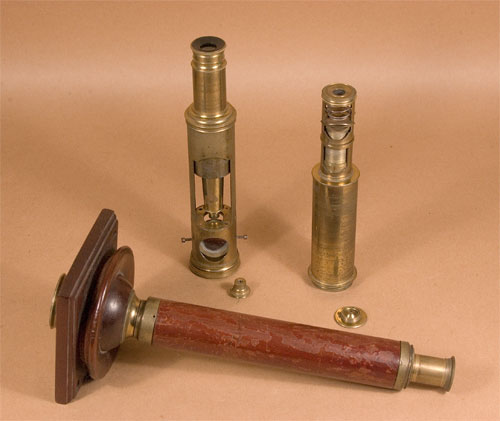Results of Golub Collection search: Microscope No. 260
Scioptic Ball Microscope Compendium (No. 260)
Made: 1740–1750
Made by: unknown
Made in: probably England
This microscope compendium consists of a box of instruments that includes a Drum microscope, a Screw-barrel microscope, a Telescope, and a Scioptic ball. A scioptic ball is a mounting device for optical components. It consists of a wooden ball in a mounting frame. The ball can be oriented in any direction and then fixed in place with a retaining ring. The ball has a hole through the middle with brass mounts on either side where an optical microscope or telescope may be attached. The telescope and screw-barrel microscope are components of a projection system much like the solar microscope of a later era. The optical instrument faces into a darkened room. Loosening the retaining ring allows the ball to rotate freely, thus pointing the outside opening toward the sun. If a telescope is attached, the system would be used for visualizing sunspots or an eclipse. By removing the telescope and retaining ring, and turning the ball around, a screw-barrel microscope can be attached to visualize mounted specimens. Both the telescope and screw-barrel microscope were used to project images for audience viewing.
The telescope was used to image sunspots, or possibly outdoor scenes. It has the typical complement of three lenses and thus inverts an image. However, the outer tube contains a fourth (positive) lens, the function of which is to invert the final (telescope) image to project an upright image. The telescope is 15cm long with inner tube retracted.
A second microscope included with this compendium is a typical Wilson-type screw-barrel magnifier. It would have been used as a projection microscope by mounting it on a brass tube, then threading the end onto the scioptric ball. In this configuration it acts as a projection system for slide mounted specimens. Illumination would have been the sun. The instrument is 17cm tall.
The third optical component is a typical drum-type compound microscope. It comes with two objectives and an illuminating mirror for imaging samples with transmitted light. It is 22–24cm tall.
In about 1750 Benjamin Martin offered a compendium of instruments in a single case, such as is displayed here, described as a Cabinet of Optical Instruments. It included a scioptic ball, drum microscope, screw-barrel microscope and telescope. Scioptic balls first appeared around 1740, and were offered by Benjamin Martin, John Cuff, and (possibly) Lieberkuhn. Scioptic balls were an evolutionary step between the Camera Obscure, Magic Lantern, and Solar microscope (with fixed tube and moveable mirror) as designed by John Cuff in 1743*.
Featured 05/2007

